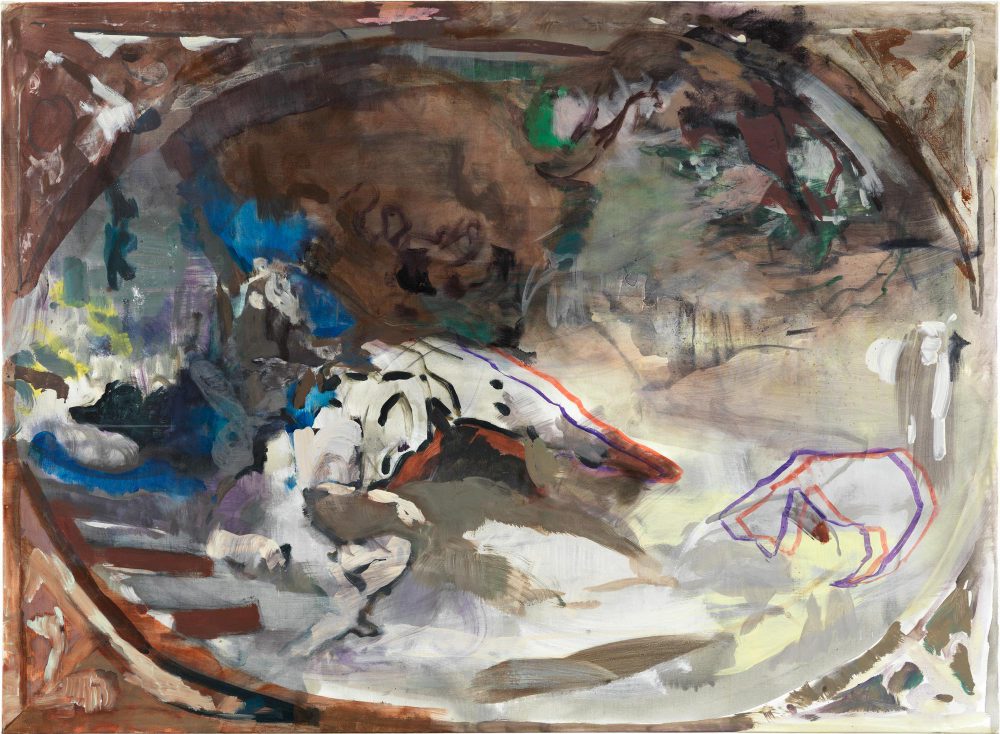
Maki Na Kamura
Solo Exhibition
"Exactly Like How a Child Who Watched Sugar Gradually Dissolve in Water Wonders Why Our Bodies Do not Dissolve That Way in the Bathtub”* *Jean Cocteau, in "A Conversation with André Fraigneau"
Saturday, September 7, 2019 - Saturday, October 5, 2019
Talk event: Maki Na Kamura × Sekai Kozuma (writer / curator)
Saturday, September 7, 2019
17:00 – 18:00
Admission free
*Registration required.
*Talk will be conducted in Japanese.
Opening reception: 18:00 – 20:00, Saturday, September 7, 2019
Gallery hours: 11:00-18:00, 11:00-20:00 (Fri)

DSM III
2019, Oil and Water on Linen, H140 x W190cm
Photo by Jens Ziehe
© Maki Na Kamura
ANOMALY is pleased to announce the upcoming solo exhibition “Exactly Like How a Child Who Watched Sugar Gradually Dissolve in Water Wonders Why Our Bodies Do not Dissolve That Way in the Bathtub”* *Jean Cocteau, in “A Conversation with André Fraigneau” by Maki Na Kamura. The exhibition will commence on September 7 and continue until October 5.
Born in Osaka and now residing in Berlin, Maki Na Kamura went to Germany after studying painting at Aichi University of the Arts. In Germany, she studied under Jörg Immendorff, who had been a student of Joseph Beuys, at the Kunstakademie Düsseldorf. After being awarded the Falkenrot Prize in 2013, she held solo exhibitions in Künstlerhaus Bethanien (Berlin) and Oldenburger Kunstverein (Oldenburg) in 2014, and Bilbao Arte – centro de arte contemporáneo (Bilbao) in 2015. This was followed in 2017 by a large solo exhibition at the Osthaus Museum Hagen (Hagen) and other solo exhibitions at CONTEMPORARY FINE ARTS (CFA, Berlin) and the Museum Dhondt-Dhaenens (Belgium). As this evidences, she has remained in extensive activity, mainly in Europe. Right now, a solo exhibition of her work is being held at the Gutshaus Steglitz in Berlin (until September 29). It should be added that some of her works are also in the collection of the Musée d’art moderne de la Ville de Paris and other museums.
Just as pianists freely interpret the works of composers and Picasso found a new style of expression through the works of Manet, Maki Na Kamura is a rare type of painter who established a new style of expression by a both innovative and original technique while clearly referencing historical artists such as Giorgione (c.1477/78-1510), Nicolas Poussin (1594-1665), Pierre Puvis de Chavannes (1824-1898), and Jean-François Millet (1814-1875), and making extensive use of European paintings from the Renaissance to the current age. She developed a distinctive palette of colors by mixing oil and water paints. The beautiful coloring born from it that has a transparent look brimming with luster and vivacity, the dynamic depictions with a layering of delicate hues minus outlines, and the impressive brush strokes recalling physical motion all continue to captivate many viewers.
Na Kamura scans images of paintings and prints from the 16th to the 18th century she finds in art books, outputs the scanning data with a simple laser printer, and incorporates the color lines and striped patterns appearing in this output. By so doing, she strives to have the painting contain the thickness of time stretching over several centuries right up to the present. In addition, she focuses on the rules of perspective (hidden line drawing) and apprehends “horizon” as a fictional vision artificially produced by the painter. Combining this in her mind with the grand adventures of mariners who crossed oceans by constantly sailing over the “waves” entering their field of vision, she actually studied navigation and often paints “horizons” as a key element for her creation of new images of the world. Furthermore, by leaving blank space on the perimeters of the canvas, she puts the very frame into the painting, and thereby unequivocally proclaims that the work is a finished painting and takes painting itself as a motif. For the titles of her works, she uses abbreviations and Roman numerals to identify those produced in a certain period while leaving the subject ambiguous, in a deliberate attempt to free the painting in question.
“Images are alive and continue to change. As long as there are people to see them, images can be taken in by various methods and linked to the next creation.” As suggested by this remark of Na Kamura’s, the new interpretation inspired by an image of the past (painting) renews the image of the present (painting).
“Exactly Like How a Child Who Watched Sugar Gradually Dissolve in Water Wonders Why Our Bodies Do not Dissolve That Way in the Bathtub”*
* Jean Cocteau, in “A Conversation with André Fraigneau”
The passage above forming the title of this exhibition is a comment by Picasso as quoted by Jean Cocteau in “A Conversation with André Fraigneau.” The source of the vague yet rich images like that contained in this passage may very well be the place which Na Kamura endeavors to paint.
Besides introducing the latest paintings of Na Kamura in this exhibition, we are planning sales of a booklet containing text written especially for it by the writer and curator Sekai Kozuma at the venue. In addition, we are holding a talk event with Na Kamura and Kozuma on the first day of the exhibition. We urge you not to miss this solo exhibition by Maki Na Kamura, a painter who continues to explore the essence and possibilities of painting amid the diversifying currents of contemporary artistic expression.





























